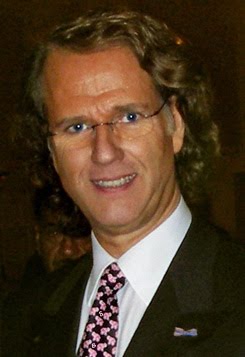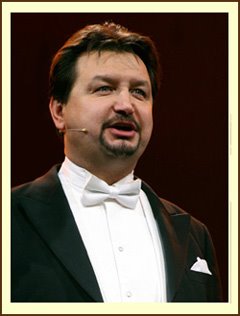Exhibition and Scientific Book Unravel The Mystery of André Rieu
Master of Detail
Nuts, that distain for popular culture.
by Marie-Therese Roosendaal
De Telegraaf: Radetzkymarch, Funiculi Funicula, the Blue Danube, Adieu mein Kleiner Gardeoffizier, Viennese blood, Auld Lang Syne, Sirtaki, Don’t cry for me Argentina. The evergreens are a constant fixture at André Rieu’s concerts, the man who gave the waltz new life. Three scientists working in Rieu's home of Maastricht were surprised that no one had ever seriously examined the phenomenon, André Rieu, and so off to work they went. Their book, "Rieu, Maestro without borders" unravels his success formula. Honorary professor of gender studies Maaike Meijer, who eagerly delves into the popular culture, was the spokesperson, and also spoke for her coauthors Jac van den Boogard and Peter Peters.
Life Songs
She wonders why André Rieu as a research project has been left alone for such a long time. Everyone says: "Hey, how is that possible! And that is that as though it speaks for itself. Nuts, really, that distain for popular culture, life is not only about Bach. The cultural spectrum is just great, rich and divers. I really like classical music and I am an omnivore. I love "Life Songs", the Jordaan (a district in Amsterdam) and the accordion. In a "life song" you can read an entire social development. Through fetlocks, and girls in high heels with Chihuahuas. When I had a girlfriend in Brabant, I enjoyed carnival music and operettas at her home. My first Rieu concert on the Vrijthof recalled an acute nostalgia of that time. "Tiritomba" immediately whisked back into that world." "Rieu always selects pieces which we have almost forgotten. That gives you an aha-moment: Oh, yes that is right, the waltz music of my parents. That enters unexpectedly and brings forth emotions." Conductor Rieu orchestrates that emotion. In classical concerts normally always the hands of musicians are only seen: Look at those violinists, how virtuous. That draws the viewer away from his own emotions. With Rieu the public is brought into view on the big screens; a waltzing couple, a mother who flips away a tear. To see people cry makes you cry, to see them laugh makes you laugh." He knows what he does: but it is more intuitive than conscious. It is based on experience. Before his break-through in 1994 with "The Second Waltz" by Sjostakovich, he had of course already performed in every "doghouse". For the elderly, for organizations. He knows what makes the public happy, or peaceful. And he lays it on thick, while with classical music one should always be composed, kind of flat and not full out. The orchestra members look fantastic, the ladies in ball gowns. It gives you the illusion of a
fairytale. And the bar is always set very high, everything goes into perfection.
Jokes
"From the operas he brings the emotionally laden arias. He then expresses his admiration for the great Puccini. And say: "Come in, classical music is also for you. Along with his orchestra he then jokes around: from the man with the triangle who fell asleep just before the crucial moment. The violinist who pretends he drank too much. It is jocular and carnival-like: people are allowed to laugh at the elite, may take revenge on their oppressors. That is reassuring: we are allowed to come in, and we are also allowed to laugh loudly. Ingenious how he lowers the threshold of the classical music." He is also a precursor to classical music, which in crisis does not know how to get full concert halls, tormenting their brains on how to turn the tide. They also want go out on the streets more often, the Amsterdam Canal Festival is a good example, or during the enthronement of Willem-Alexander, the performance of DJ Armin van Buuren with the Concert Building orchestra. And Rieu does it all by himself, clever, in a culture where since the fifties the building subsidy became ever higher. It is no secret that he would like to conquer the world, and he is well on his way: he is especially successful in Australia, more so than in the Netherlands and Germany. I guess that is because classical music there is less prescriptive and less averse to the state of the popular genre. And in America they think of Rieu as classic." Maaike Meijer enjoyed the performances: "Nicer than CD’s. The encores are a concert all by themselves. It is one folk fest, the public goes crazy. And me too!" Is the maestro sometimes accused of megalomania, which she too places in context: Of course Andre Rieu is megalomaniac! Without his great dreams he would never have come this far. But that millions around the world enjoy his music is his most important drive."
Pomp and Pageantry almost touchable
Below the portraits of his teachers, Robert Stolz and Herman Krebbers you find the sofa bed of André Rieu. Stella Schurgers laughs: "The real one! He has four, and one always accompanies him. Just prior to every concert he lies down for a little while in order to charge himself up again." Stella, a Maastricht Rieu fan from the first hour, sits ringside as a volunteer coordinator at the Museum on the Vrijthof. Tomorrow the André Rieu exposition "Love for Detail" opens. A museum, which otherwise just like André Rieu, runs without a penny of subsidy. Inspired director Erik de Jong states: "Made in Maastricht is our motto. And then you very quickly wind up with Maastricht’s favorite son. His story is now well known, so to go there again ...
Approach
He racked his brain about a new approach: "When I was in his studio I noticed images of Maastricht hanging on the wall. He told me he had sent a winter scene back to the artist since it did not depict snow. And although the artist pointed out the bare trees, winter for him means snow. OK, so she added snowflakes. And I had my theme; "Rieu’s eye for detail." I hesitate to use the word perfectionist, which to me indicates a fear of failure. He is not afraid; he just wants to make it precise. Stella Schurgers is admiring the Sissi dresses with the small waistlines and hoop skirts. "During the concerts on the Vrijthof from row 32 you only see the contours, now this pump and pageantry is almost touchable."
In the museum a studio has been furnished, complete with ironing board and sewing machine. Small suitcases are lined up in a row: Every musician has his own suitcase, with their own things. Glittery pumps, a small makeup bag, jewelry, photo of the violinist on the inside of the suit case lid. "That means four times the same suit cases with the same identical contents. For everyone. That again is perfection. If one suitcase happens to be in Bucharest for a concert, the second one might be on its way to Australia for the next concert series."
Dresses
On the wall you can read the story how Rieu comes to the costume department with pictures of dresses he has seen in the series "The Tudors" and in the movie "The Other Boleyn Girl." "Get inspired and pay attention to the details" was his directive. The results are displayed on a mannequin, the blue- white dream dress of soloist Carla Maffioletti. In the museum even a ballroom has been laid out. Dance school Bernaards even placed dance steps of a waltz on the floor. Schurgers laughs: "I can see myself swirling around here! I have known André Rieu long before he became so big. With Hieringe Biete, eating herring pieces on Ash Wednesday, he always performed with the Salon Orchestra on Our Dear Ladies Square. (Onze Lieve Vrouwe plein) Even then he brought people into exaltation." Musical scores, a black and white photo of a little André with violin and all the program booklets. But the highlight of the exhibition is a live presentation: the Maastricht luthier Niels Rijsemus. Unperturbed he keeps on plaining wooden curls. Then he beams:"My first violin went to André. A great honor. And in 40 years from now I will still recognize that sound. The sound from the violin and from André Rieu."
Thanks to John for the Translation - his last before leaving for Europe on a well earned vacation!






































































































































